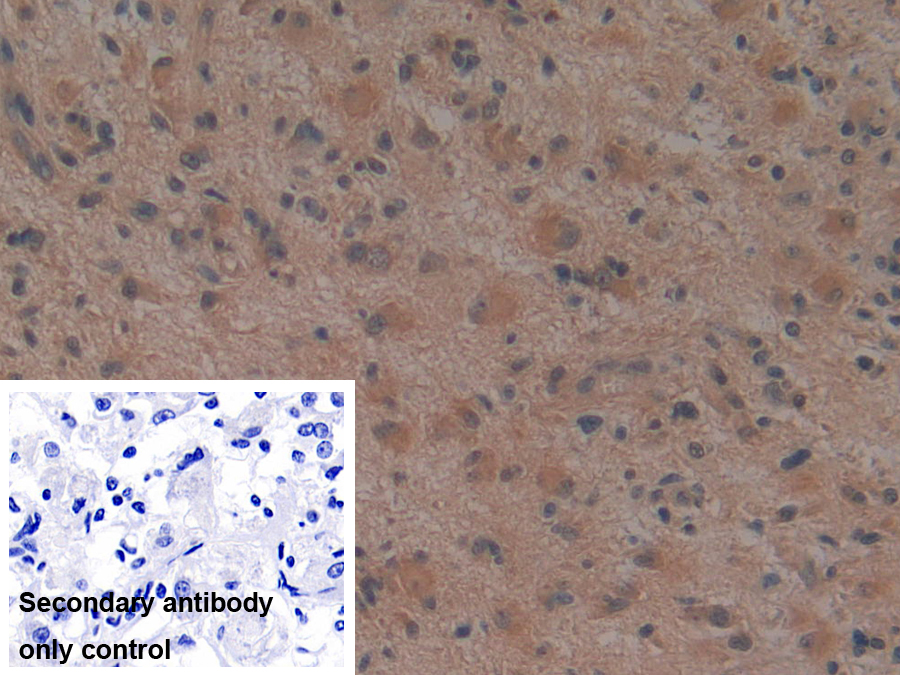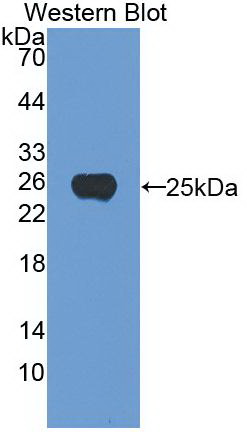Monoclonal Antibody to Noggin (NOG) 

SYM1; SYNS1; Synostoses(Multiple)Syndrome 1; Symphalangism 1(Proximal)
Overview
Properties
- Product No.MAC130Hu22
- Organism SpeciesHomo sapiens (Human) Same name, Different species.
- ApplicationsIHC
If the antibody is used in flow cytometry, please check FCM antibodies.
Research use only - DownloadInstruction Manual
- CategorySignal transductionImmune moleculeNeuro scienceBone metabolism
- SourceMonoclonal antibody preparation, Host Mouse
- Ig Isotype IgG2b Kappa, Clone Number A7
- PurificationProtein A + Protein G affinity chromatography
- LabelNone
- Immunogen RPC130Hu01-Recombinant Noggin (NOG)
- Buffer Formulation0.01M PBS, pH7.4, containing 0.05% Proclin-300, 50% glycerol.
- TraitsLiquid, Concentration 1mg/mL
Sign into your account
Share a new citation as an author
Upload your experimental result
Review

Contact us
Please fill in the blank.
Specifity
The antibody is a mouse monoclonal antibody raised against NOG. It has been selected for its ability to recognize NOG in immunohistochemical staining and western blotting.
Usage
Western blotting: 0.01-3µg/mL;
Immunohistochemistry: 5-30µg/mL;
Optimal working dilutions must be determined by end user.
Storage
Store at 4°C for frequent use. Stored at -20°C in a manual defrost freezer for two year without detectable loss of activity. Avoid repeated freeze-thaw cycles.
Stability
The thermal stability is described by the loss rate. The loss rate was determined by accelerated thermal degradation test, that is, incubate the protein at 37°C for 48h, and no obvious degradation and precipitation were observed. The loss rate is less than 5% within the expiration date under appropriate storage condition.
Giveaways
Increment services
-
 Antibody Labeling Customized Service
Antibody Labeling Customized Service
-
 Protein A/G Purification Column
Protein A/G Purification Column
-
 Staining Solution for Cells and Tissue
Staining Solution for Cells and Tissue
-
 Positive Control for Antibody
Positive Control for Antibody
-
 Tissue/Sections Customized Service
Tissue/Sections Customized Service
-
 Phosphorylated Antibody Customized Service
Phosphorylated Antibody Customized Service
-
 Western Blot (WB) Experiment Service
Western Blot (WB) Experiment Service
-
 Immunohistochemistry (IHC) Experiment Service
Immunohistochemistry (IHC) Experiment Service
-
 Immunocytochemistry (ICC) Experiment Service
Immunocytochemistry (ICC) Experiment Service
-
 Flow Cytometry (FCM) Experiment Service
Flow Cytometry (FCM) Experiment Service
-
 Immunoprecipitation (IP) Experiment Service
Immunoprecipitation (IP) Experiment Service
-
 Immunofluorescence (IF) Experiment Service
Immunofluorescence (IF) Experiment Service
-
 Buffer
Buffer
-
 DAB Chromogen Kit
DAB Chromogen Kit
-
 SABC Kit
SABC Kit
-
 Long-arm Biotin Labeling Kit
Long-arm Biotin Labeling Kit
-
 Real Time PCR Experimental Service
Real Time PCR Experimental Service
Citations
- Imbalance between BMP2 and Noggin induces abnormal osteogenic differentiation of mesenchymal stem cells in ankylosing spondylitisPubMed: 26413886
- Imbalance Between Bone Morphogenetic Protein 2 and Noggin Induces Abnormal Osteogenic Differentiation of Mesenchymal Stem Cells in Ankylosing SpondylitisPubmed:26413886
- Oxygen-glucose deprivation preconditioning protects neurons against oxygen-glucose deprivation/reperfusion induced injury via bone morphogenetic protein-7 mediated ERK, p38 and Smad signalling pathways.Pubmed:26385023
- The BMP2 variant L51P restores the osteogenic differentiation of human mesenchymal stromal cells in the presence of intervertebral disc cells.pubmed:28266688
- mbalance Between Bone Morphogenetic Protein 2 and Noggin Induces Abnormal OsteogenicDifferentiation of Mesenchymal Stem Cells in Ankylosing Spondylitis.pubmed:26413886
- The BMP antagonist Noggin is produced by osteoblasts in response to the presence of prostate cancer cells.pubmed:28981962
- Efficient in vitro delivery of Noggin siRNA enhances osteoblastogenesispubmed:29167826
- Low‐intensity pulsed ultrasound promotes bone morphogenic protein 9‐induced osteogenesis and suppresses inhibitory effects of inflammatory cytokines on cellular …Pubmed: 31006911
- Effect of tadalafil on penile nitric oxide synthase and corporal smooth muscle in rats under dutasteride treatmentPubmed: 32160825
- Effect of Simvastatin Use in Free Tissue Transfer: An Experimental Study in a Rat Epigastric Free Flap ModelPubmed: 31995818
- Slow diffusion on the monolayer culture enhances auto/paracrine effects of Noggin in differentiation of human iPS cells induced by BMPPubmed:35005256







